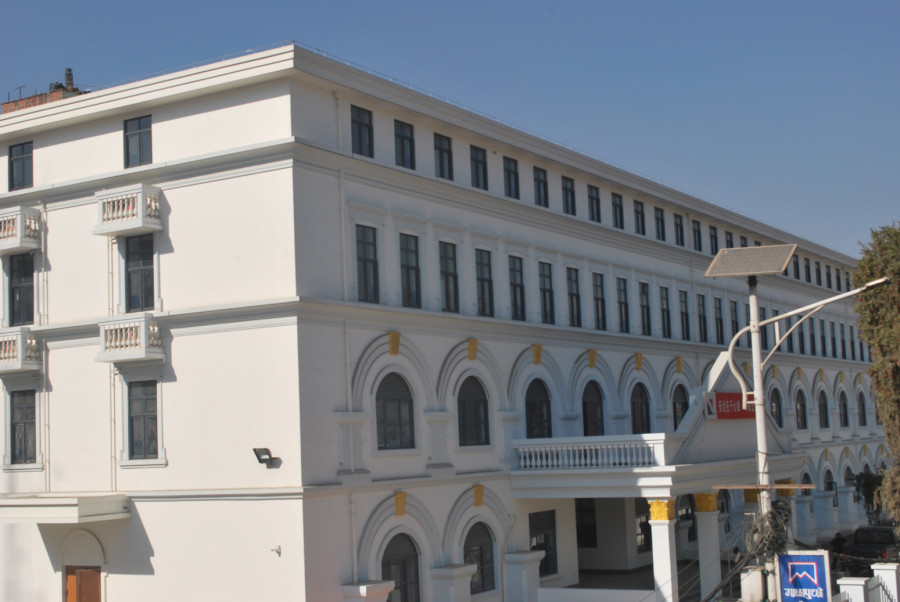Valley
Durbar High School has new building, more rooms and better facilities, but it lacks concrete plan
There’s no school management committee and the city authority responsible for operating the school has yet to draw up guidelines to run the historic institution.
Anup Ojha
The historic Durbar High School, which was ravaged by the 2015 earthquakes, is back in shape. The new four-storey building, which looks sturdy and chic, has a total of 46 rooms. Reconstructed by Shanghai Construction Group, a Chinese company, at a cost of Rs850 million, the school building will be handed over to the Nepal government by the Chinese government next month.
The new building has the capacity to accommodate around 1,000 students. It has a computer and science labs, an auditorium hall and a canteen apart from other facilities. But what it does not have is plans. The authorities concerned have yet to put a concrete plan in place on how the school will be run.
For the school’s smooth functioning, it first needs a management committee. But the management committee was dissolved two weeks ago, after Hemchandra Mahat, principal of the school, retired.
“I am told the school is going to be handed over to the Nepal government by the Chinese government in a month. The new session is going to start from mid-April,” said Mahat. “But till date, no meetings have been held. We don’t know how we will be running the classes in the new session.”
The school management committee, in coordination with the Education Department of the Kathmandu Metropolitan City, which is entrusted with the task of running the school, is responsible to prepare guidelines for the school’s daily administration.
Durbar High School, whose history dates back to the 1800s, is the country’s first school and was a centre for education during its heydays. Prime Minister Jung Bahadur Rana built the school in 1853 to educate the children of the upper ruling class Rana families.
Later, members of the public also were allowed to enrol, but only those from well-off families could afford to send their wards to the school. Attending Durbar High School, which was renamed Bhanu Secondary School in 1967, was a matter of prestige, as it was the only English medium school in the country.
Then, in 1950, the Rana regime fell. And with the advent of democracy, more schools opened up. Durbar High School gradually started to lose its sheen.
Those who could afford an “English education” started sending their children to newly cropped-up “boarding schools”, and the government lost its focus on the school.
By the time democracy was restored in 1990, the school, after years of neglect, had become a poor representation of the institution it once was. It became a place where the children of the poor and marginalised could get an education, as they could not afford to go anywhere else.
“I send my son and daughter to Durbar High School because I can’t afford to send them to other private schools. Education is free at the school,” said Prem Maya Sunwar, 43, who sells clothes in the footpath in Ratnapark during the evenings with her husband. Sunwar, with her family of four, lives in Chhetrapati in a rented room.
Before the school was damaged by the 2015 earthquakes, the older building had been running two schools from its premises—Bhanu School (with 165 students) during the day and Sanskrit School (with 250 students) in the morning shift.
Bhanu runs classes from nursery to class 10 while the Sanskrit school runs classes for sixth- to 12-graders.
Currently, students of both schools are being taught at Temporary Learning Centre structures constructed by the Chinese government on the premises of Balmiki Vidyapith Mahavidyalaya in Pradarshani Marg. Now that the building is complete, students of both the schools will be moved back to Durbar High School. But administratively, the school is not ready.
Tarapati Kharel, acting education officer at the Kathmandu Metropolitan City, said currently, there is no vision for running the school.
“Teachers at the school are good. And now we have good infrastructure as well,” Kharel told the Post. “Once the school management committee is formed, it will decide on how we move forward.”
“But what the school does not have now is plans for the optimum utilisation of facilities,” said Mahat.
Until 2015, education was free in the Durbar school. Officials said discussions are yet to be held on how the school will be run, whether there will be a new fee structure or if the government is going to take the responsibility of the upkeep of the school.
Binay Kumar Kushiyaip, an educationalist, said it is unfortunate that authorities have not been able to capitalise on this opportunity to upgrade the school. “Durbar High School is the oldest school in the country, and the federal and local government should work to turn it into a model educational institution, keeping intact its inclusiveness,” said Kushiyaip. “But both the central and local governments are not seriously working to make this school a model educational institution.”
As per the constitutional provision, school education now comes under the jurisdiction of the local governments.
“The federal government coordinated with the Chinese government for the reconstruction of the school. Now construction has been completed,” said Deepak Sharma, joint secretary and spokesperson for the Education Ministry. “Now it’s the responsibility of the local level to revive Durbar High School’s lost glory; the metropolitan city should take this responsibility.”
Kathmandu Mayor Bidya Sundar Shakya, however, appeared less concerned.
“There won’t be any separate plan for Durbar High School. All the community schools in the city will get equal priority,” Shakya told the Post. “It’s the school management committee that should manage the school. If it needs any assistance, then the Kathmandu Metropolitan City is ready to help.”




 14.12°C Kathmandu
14.12°C Kathmandu.jpg)










